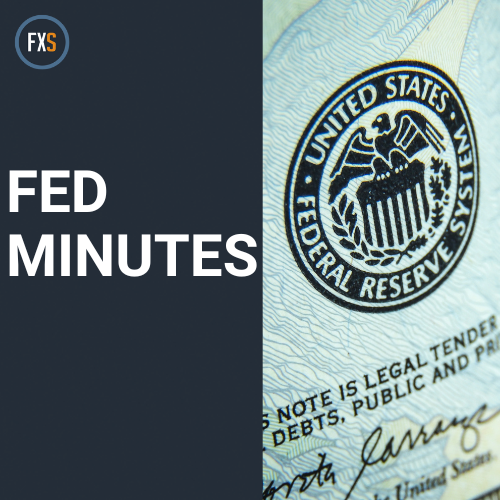Fed Minutes Preview: Markets to look for hints over interest-rate outlook as hopes for June cuts wane
- The Fed will release the minutes of the March policy meeting on Wednesday.
- Jerome Powell and co’s discussions surrounding the policy pivot will be scrutinized.
- Markets see a nearly 50% probability of another Fed policy hold in June.

The Federal Reserve (Fed) will release the minutes of the March policy meeting on Wednesday. Investors will pay close attention to comments regarding the inflation outlook and the possible timing of a policy pivot.
Fed faces a tough policy decision in June
The Fed left unchanged its monetary policy settings following the March 19-20 policy meeting as expected. The revised Summary of Economic Projections, also known as the dot plot, showed that policymakers were still projecting a total of 75 basis points (bps) reduction in the policy rate in 2024.
In the post-meeting press conference, Federal Reserve Chairman Jerome Powell repeated that they need “greater confidence” of inflation moving toward the 2% target in a sustainable way before starting to cut interest rates. Although markets saw a strong probability of a policy pivot in June, hawkish comments from Fed officials since the March meeting and the impressive labor market data caused investors to reassess the rate outlook.
Atlanta Fed President Raphael Bostic noted that he was expecting the US central bank to lower the policy rate once this year, most likely in the last quarter. On another note, “I believe it’s much too soon to think about cutting interest rates,” Dallas Fed President Lorie Logan said, citing upside risks to inflation. Additionally, Minneapolis Fed President Neel Kashkari said that he pencilled in two interest rate cuts this year and added: "If we continue to see inflation moving sideways, then that would make me question whether we need to do those rate cuts at all."
Meanwhile, the US Bureau of Labor Statistics (BLS) reported that Nonfarm Payrolls rose 303,000 in March, beating the market expectation for an increase of 200,000 and highlighting the persistent strength of the labor market.
Following the hawkish Fed commentary and March jobs report, the probability of a June rate cut declined toward 50% from above-60% earlier in the week, according to the CME FedWatch Tool.
Previewing the March Federal Open Market Committee (FOMC) Minutes “the FOMC opted again for patience at its March meeting as it continues to look for evidence that provides ‘greater confidence’ around inflation moderation. Fed officials also stuck with their median projection of 3 rate cuts for this year, despite upgrading most macro projections for 2024,” TD Securities analysts said in a note. “Debates about the short-term policy outlook and QT tapering will garner most attention,” they added.
When will FOMC Minutes be released and how could it affect the US Dollar?
The Fed will release the minutes of the March policy meeting at 18:00 GMT on Wednesday. Although investors are likely to pay close attention to this publication, its impact on the USD’s valuation could remain limited because the BLS will release the Consumer Price Index (CPI) data for March earlier in the day, which is likely to have a more significant effect on the market pricing of the Fed’s policy outlook.
Nevertheless, in case the FOMC Minutes show that some policymakers remain optimistic about the inflation outlook and still favor a rate cut in June regardless of the stronger-than-expected CPI data for January and February, the USD could face some bearish pressure. On the other hand, the USD is likely to gather strength against its rivals with the immediate reaction if the publication suggests that officials are likely to delay a rate cut as long as labor market conditions remain tight.
Eren Sengezer, European Session Lead Analyst, shares a brief technical outlook for the USD Index:
“The 200-day Simple Moving Average (SMA) aligns as key support for the USD Index (DXY) at 103.80. In case the index falls below that level and starts using it as resistance, 103.40 (100-day SMA) could be seen as next support before 102.35 (March 8 low). On the upside, the Fibonacci 61.8% retracement of the October-December downtrend aligns as first resistance at 104.70 before 105.00 (static level) and 105.80 (Fibonacci 78.6% retracement).”
US Dollar FAQs
The US Dollar (USD) is the official currency of the United States of America, and the ‘de facto’ currency of a significant number of other countries where it is found in circulation alongside local notes. It is the most heavily traded currency in the world, accounting for over 88% of all global foreign exchange turnover, or an average of $6.6 trillion in transactions per day, according to data from 2022. Following the second world war, the USD took over from the British Pound as the world’s reserve currency. For most of its history, the US Dollar was backed by Gold, until the Bretton Woods Agreement in 1971 when the Gold Standard went away.
The most important single factor impacting on the value of the US Dollar is monetary policy, which is shaped by the Federal Reserve (Fed). The Fed has two mandates: to achieve price stability (control inflation) and foster full employment. Its primary tool to achieve these two goals is by adjusting interest rates. When prices are rising too quickly and inflation is above the Fed’s 2% target, the Fed will raise rates, which helps the USD value. When inflation falls below 2% or the Unemployment Rate is too high, the Fed may lower interest rates, which weighs on the Greenback.
In extreme situations, the Federal Reserve can also print more Dollars and enact quantitative easing (QE). QE is the process by which the Fed substantially increases the flow of credit in a stuck financial system. It is a non-standard policy measure used when credit has dried up because banks will not lend to each other (out of the fear of counterparty default). It is a last resort when simply lowering interest rates is unlikely to achieve the necessary result. It was the Fed’s weapon of choice to combat the credit crunch that occurred during the Great Financial Crisis in 2008. It involves the Fed printing more Dollars and using them to buy US government bonds predominantly from financial institutions. QE usually leads to a weaker US Dollar.
Quantitative tightening (QT) is the reverse process whereby the Federal Reserve stops buying bonds from financial institutions and does not reinvest the principal from the bonds it holds maturing in new purchases. It is usually positive for the US Dollar.
Economic Indicator
FOMC Minutes
FOMC stands for The Federal Open Market Committee that organizes 8 meetings in a year and reviews economic and financial conditions, determines the appropriate stance of monetary policy and assesses the risks to its long-run goals of price stability and sustainable economic growth. FOMC Minutes are released by the Board of Governors of the Federal Reserve and are a clear guide to the future US interest rate policy.
Read more.Last release: Wed Feb 21, 2024 19:00
Frequency: Irregular
Actual: -
Consensus: -
Previous: -
Source: Federal Reserve
Minutes of the Federal Open Market Committee (FOMC) is usually published three weeks after the day of the policy decision. Investors look for clues regarding the policy outlook in this publication alongside the vote split. A bullish tone is likely to provide a boost to the greenback while a dovish stance is seen as USD-negative. It needs to be noted that the market reaction to FOMC Minutes could be delayed as news outlets don’t have access to the publication before the release, unlike the FOMC’s Policy Statement.
Author

FXStreet Team
FXStreet

















